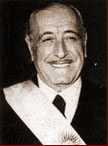- Héctor José Cámpora
Infobox_President | name=Héctor Cámpora
small
caption=Hector Campora ("left") upon being sworn in.
nationality=Argentine
order=39thPresident of Argentina
term_start=May 25 ,1973
term_end=July 12 ,1973
predecessor=Alejandro Lanusse
successor=Raúl Lastiri
birth_date=March 26 ,1909
birth_place=Mercedes, Buenos Aires
death_date=December 18 ,1980
death_place=Mexico City
spouse=
party=Justicialist
vicepresident=Vicente Solano Lima
profession=Dentist Héctor José Cámpora Demaestre (1909-1980) was president of
Argentina fromMay 25 untilJuly 13 1973 .Cámpora, affectionately known as "el Tío" (the Uncle), was born in the city of Mercedes, in the
Province of Buenos Aires . He earned a degree indentistry in Córdoba and practiced his profession in his hometown before moving to nearby San Andrés de Giles.As
Juan Perón 's "personal delegate," he ran for president in 1973 to circumvent the veto on Perón's participation in the election which had been issued by Argentine dictator Gen. Alejandro Lanusse. The presidential ticket also carriedVicente Solano Lima as candidate for vice president. Despite Cámpora's own left-leaning tendencies, Solano Lima belonged to the Popular Conservative Party.Cámpora won the election with 49.5% of the votes. The Radical leader,
Ricardo Balbín , had arrived second with 25%, but it was enough to include Cámpora in the runoff, asabsolute majority was necessary to avoid a second ballot. However, he resigned his right in order to avoid a political crisis, and recognized his defeat. Cámpora assumed his functions on May 25, 1973, in the presence of Chilean PresidentSalvador Allende and Cuban PresidentOsvaldo Dorticós . A million persons gathered on the "Plaza de Mayo " to acclaim the new President.One of Cámpora's first presidential actions was a granting of
amnesty topolitical prisoner s who where jailed during the dictatorship prior to his assumption.On
May 28 Argentina restored diplomatic relations with Cuba, which then received Argentine aid - such as food and industrial products - to break theUnited States embargo against Cuba .During Cámpora's first months of government, approximatively 600 social conflicts, strikes and factory occupations had taken place. [ Hugo Moreno, "Le désastre argentin. Péronisme, politique et violence sociale (1930-2001)",
Editions Syllepses , Paris, 2005, p.109 fr icon ] Cámpora's ideology set him against the right-wing tendencies ofPeronism . When Perón returned to Argentina (June 20 ,1973 ), his plane had to be redirected to a military airport because of fighting between armed Peronist factions that had massed to greet his arrival at Buenos Aires's main airport. This event, known as theEzeiza Massacre , left 13 dead.José Ber Gelbard , president of a small and medium-sized enterprise association, was designated as minister of economics. Gelbard tried to establish a "social pact" among the CGT workers and the "NationalBourgeoisie ", including aprice freeze and widespread salary hikes.Finally, on
July 13 ,1973 Cámpora resigned to allowJuan Perón to return to power. He was later designated as Argentine ambassador toMéxico .After the
coup d'etat that displaced Perón's successor, wifeIsabel Perón , in 1976, Cámpora sought refugee at the Mexican embassy in Buenos Aires. Three years later, he was allowed to fly to México. Cámpora died inCuernavaca shortly after his arrival.References
ee also
*
Peronism
*Montoneros (left-wing Peronists)
*Movimiento Nacionalista Tacuara (neofascists who supported Perón's return)
*June 1973Ezeiza massacre
*History of Argentina External links
* [http://enciclopedia.us.es/index.php/Héctor_José_Cámpora Enciclopedia Libre Universal en Español - Héctor José Cámpora] . Original version in Spanish, released under GNU FDL.
Wikimedia Foundation. 2010.
